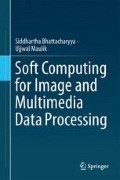Abstract
An interesting application of the soft computing paradigm involving fuzzy set-theoretic concepts is the tracking of targets from a motion scene preceded by faithful extraction of motion object features and prototypes. Tracking is essentially a three step process. The first step is involved in analyzing the motion scene under consideration for extracting moving object-centric features. Subsequently, the selected features are used to segment/cluster the motion scene into several moving object regions. Finally, the feature space is updated based on the analysis of the segmented motion scene for future retrieval of moving object regions.
Access this chapter
Tax calculation will be finalised at checkout
Purchases are for personal use only
References
S. Bhattacharyya, U. Maulik, P. Dutta, High-speed target tracking by fuzzy hostility-induced segmentation of optical flow field. Int. J. Appl. Soft Comput. 9, 126–134 (2009)
S. Bhattacharyya, P. Dutta, Multiscale object extraction with MUSIG and MUBET with CONSENT: a comparative study, in Proceedings of KBCS 2004, Hyderabad, India, Dec 2004, pp. 100–109
B.K.P. Horn, B.G. Schunck, Determining optical flow. Artif. Intell. 17, 185–204 (1981)
S.S. Beauchemin, J.L. Barron, The computation of optical flow. ACM Comput. Surv. 27(3), 433–467 (1995)
D.J. Heeger, Optical flow using spatiotemporal filters. Int. J. Comput. Vis. 1, 279–302 (1988)
L. Jacobson, H. Wechsler, Derivation of optical flow using a spatiotemporal-frequency approach. Comput. Vis. Graph. Image Process. 38, 29–65 (1987)
B.J.T. Fernandes, G.D.C. Cavalcanti, T.I. Ren, Classification and segmentation of visual patterns based on receptive and inhibitory fields, in Proceedings of the 8th International Conference on Hybrid Intelligent Systems, Barcelona, 2008, pp. 126–131
Author information
Authors and Affiliations
Rights and permissions
Copyright information
© 2013 Springer-Verlag Berlin Heidelberg
About this chapter
Cite this chapter
Bhattacharyya, S., Maulik, U. (2013). Target Tracking Using Fuzzy Hostility Induced Segmentation of Optical Flow Field. In: Soft Computing for Image and Multimedia Data Processing. Springer, Berlin, Heidelberg. https://doi.org/10.1007/978-3-642-40255-5_4
Download citation
DOI: https://doi.org/10.1007/978-3-642-40255-5_4
Published:
Publisher Name: Springer, Berlin, Heidelberg
Print ISBN: 978-3-642-40254-8
Online ISBN: 978-3-642-40255-5
eBook Packages: Computer ScienceComputer Science (R0)

